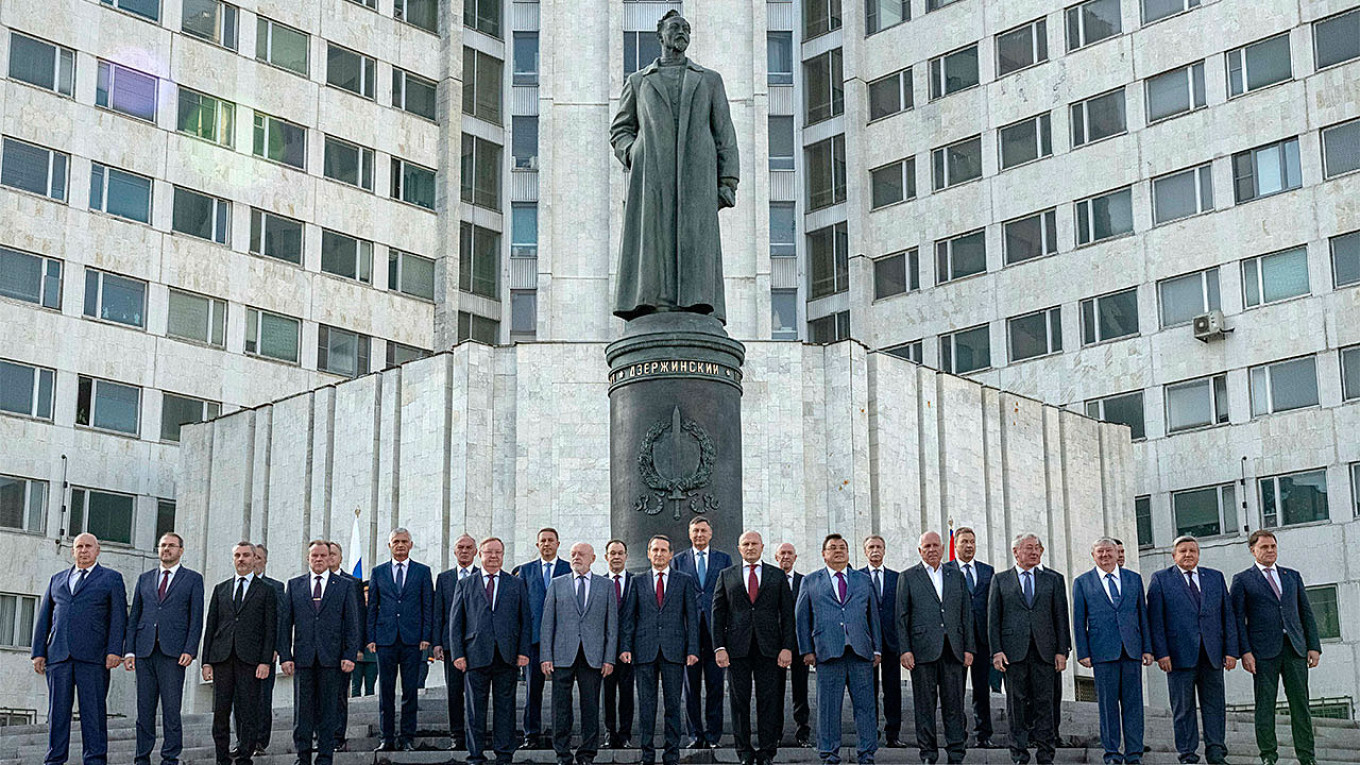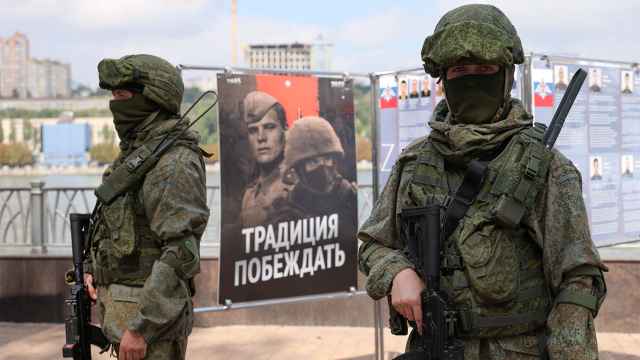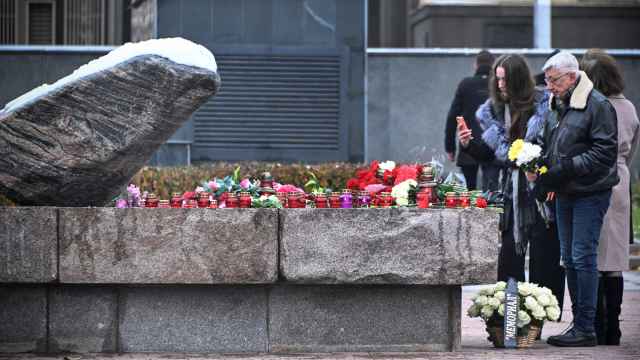A row of men in suits stands at attention, a dark bronze statue towering between them and a grey high-rise looming behind. A solemn speech praises a state official as a “model of crystalline integrity, self-sacrifice and devotion to duty.” Devoid of color and spontaneity, the scene could hardly appear more Soviet. Yet it played out last week, at the unveiling of a monument to Bolshevik secret police chief Felix Dzerzhinsky at the Foreign Intelligence Service (SVR) headquarters in Moscow.
Fallen statues often serve as a visual shorthand for radical social and political change, from Saddam Hussein’s monument in Iraq in 2003 and the dismantling of Lenin statues across Ukraine since the early 2010s to the toppling of Bristol’s Edward Colston statue during anti-slavery protests in 2020. These images have a seductive but misleading clarity. While hailed as symbols of the rejection of a despised past, they gradually reveal a more complicated confrontation and contestation of memories.
The Dzerzhinsky monument’s return has already prompted an outpouring of celebrations and disgust. Conservative politicians and pundits crow that Dzerzhinsky is finally back in his rightful place. For liberals and opposition figures, the renewed tribute to a Soviet “hangman” offers further proof for their alarms over Russia’s descent into a repressive dictatorship. Dzerzhinsky was the architect of the "Red Terror", a sweeping campaign of executions and repressions aimed at stamping out opposition to the Bolsheviks. Historians have placed the number of dead as high as 200,000.
If the Soviet collapse were summed up in a single image, it might well be that of pro-democracy protesters cheering on the night of Aug. 22, 1991, as the 12-foot, 11-ton statue of Dzerzhinsky was lifted by a crane onto a flat-bed truck. As it teetered on its graffitied pedestal in the shadow of the notorious KGB headquarters at Lubyanka, the statue’s removal seemed to herald a new age of freedom. The first head of the Bolshevik Secret Police (Cheka), Dzerzhinsky now looked like the last vestige of its reign of terror. That the square’s sole monument was now the Solovetsky Stone, installed by the now-banned Memorial NGO in memory of Soviet repression, further epitomized the apparent sea change in attitudes.
The afterlife of Dzerzhinsky’s monument in post-Soviet Russia has come to symbolize neither the complete rejection nor wholesale return of a violent past. It shows instead how Russian officials use aspects of history as a model and justification for the present. It is thus no accident that Dzerzhinsky’s long-awaited (or long-feared) return was announced last Monday by Putin’s spymaster Sergei Naryshkin, amid Russia’s full-scale invasion of Ukraine and crackdown on domestic “foreign agents.”
I first visited Russia during (and thanks to) Gorbachev’s reforms in 1991. The Intourist itinerary of our school trip avoided Lubyanka Square, so I missed the chance to glimpse Dzerzhinsky in situ. When I returned a few years later as a graduate student, he already had a new home. Not long after the coup, the Moscow authorities had moved the statue to languish amid a jumble of Soviet paraphernalia in the so-called Graveyard of Fallen Monuments. Traces of the 1991 attacks were still visible on the pedestal, just as a nearby Stalin statue sported a smashed nose. The method of its removal showed that violent intolerance should have no place in the new, supposedly democratic Russia. It was hard to imagine that Dzerzhinsky’s monument, and what it symbolized, could ever be restored.
Discussions of the statue’s return regularly punctuated central and municipal politics in the 90s and 2000s, often framed in apolitical terms. Supporters emphasized its architectural benefits, arguing that Lubyanka Square lacked coherence without a monumental focal point. However, notes of nostalgia and admiration for Dzerzhinsky soon started to creep in from more than just the Communist fringes. Among those clamoring for his return over the last quarter century have been a Mayor of Moscow and numerous State Duma deputies. President Vladimir Putin himself has never stated his position, though it is not hard to guess.
Dzerzhinsky’s path back to Lubyanka was strewn with roadblocks. The last attempt to return a statue to the square, two years ago, pitted him in a Moscow-wide competition with the medieval prince Alexander Nevsky. When Nevsky pulled into an early lead, the vote was called off.
Details are scarce on the decision-making behind the 2023 sculpture, and how sculptor Vladimir Ivanov created his reproduction of the original. But it seems likely to be popular within the SVR, whose headquarters have housed a bas-relief of Dzerzhinsky since the start of the decade, even if outside opinion is decidedly more mixed.
Dzerzhinsky’s stubborn haunting of post-Soviet politics recalls the campaign to rename the city of Volgograd to Stalingrad. Though the plans have now progressed further than ever before, “Stalingrad” does not yet feature on post-Soviet maps. The contrast is telling. Despite feeding off the cult of what Russians call the Great Patriotic War and increasingly resembling Stalinism, Putin’s regime does not view the Stalin era as a fully usable past. However, the cult of the Secret Police is going from strength to strength.
In fact, the original Dzerzhinsky statue was commissioned during Soviet attempts to dissociate the Secret Police from Stalinist terror. Its 1958 unveiling formed part of what historian Julie Fedor calls a “rebranding,” which peaked during Yuri Andropov’s tenure as chairman of the KGB. Throughout the Soviet era, though, the Dzerzhinsky myth highlighted his apparent humanity and commitment to “legality”. His work on child homelessness fostered an image of fatherly kindness, strengthened by the proximity of his statue to Moscow’s largest children’s department store.
Despite engineering the brutal Bolshevik “Red Terror” and other bloody campaigns, Dzerzhinsky’s Cheka is still widely seen as more humane than the brutal Stalinist NKVD. It can plausibly be claimed that he had no connection to the latter, having died eight years before its founding.
In a country headed by a former KGB agent, whose policing draws on the Soviet playbook while keeping secret police archives closed to historians, it is unsurprising that this sanitized image of the Cheka is thriving. The return of “Iron Felix” also conveys a willingness to crack down hard on enemies of the state, a point emphasized by Naryshkin and state media. Like other Putinist historical symbols, this myth harbors layers of meaning, which can be activated depending on the political demands and audiences of the moment.
In recent years, several new busts and statues of Dzerzhinsky, and even some of Stalin, have cropped up across Russia (as well as Dzerzhinsky’s native Belarus). They lack the physical and mythological stature of the Lubyanka Dzerzhinsky, however. The new statue stands almost 30 kilometers from the city center, and is a downsized facsimile of its monumental predecessor. These controversial Soviet symbols have not made a full return, and do not occupy the very center of Russian space or its political agenda. But perhaps they don’t need to.
While the future of the Soviet past remains unpredictable, to quote historian Nanci Adler, some parts fit very well with the present. In a state obsessed with internal and external enemies, the merciless but honorable Chekist, in the eyeline of today’s secret agents and with his own gaze trained toward Russia’s western borders, seems perfectly at home where he now stands.
A Message from The Moscow Times:
Dear readers,
We are facing unprecedented challenges. Russia's Prosecutor General's Office has designated The Moscow Times as an "undesirable" organization, criminalizing our work and putting our staff at risk of prosecution. This follows our earlier unjust labeling as a "foreign agent."
These actions are direct attempts to silence independent journalism in Russia. The authorities claim our work "discredits the decisions of the Russian leadership." We see things differently: we strive to provide accurate, unbiased reporting on Russia.
We, the journalists of The Moscow Times, refuse to be silenced. But to continue our work, we need your help.
Your support, no matter how small, makes a world of difference. If you can, please support us monthly starting from just $2. It's quick to set up, and every contribution makes a significant impact.
By supporting The Moscow Times, you're defending open, independent journalism in the face of repression. Thank you for standing with us.
Remind me later.






